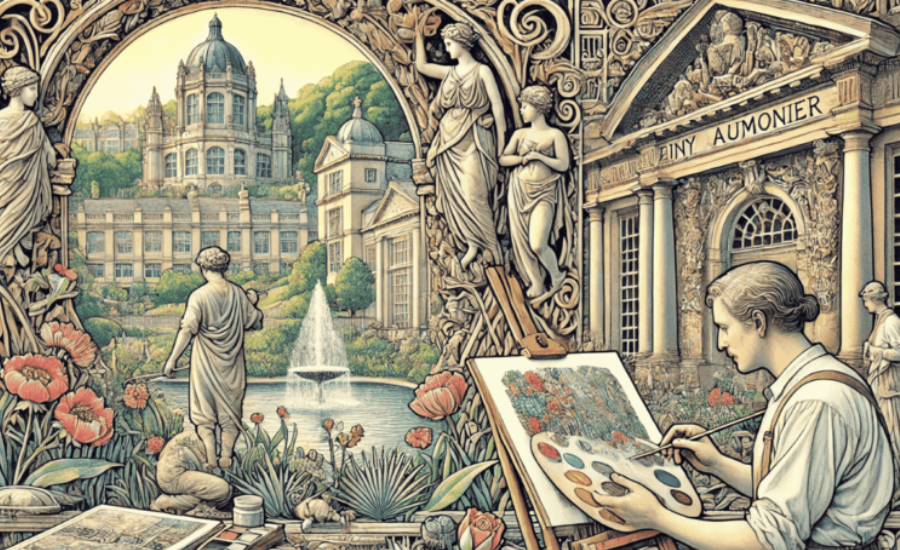William and Tiny Aumonier may not be widely recognized in mainstream art and architecture circles, yet their influence has endured, quietly shaping the creative landscape with their remarkable works. William, a gifted sculptor and architect, was not simply focused on constructing buildings or sculptures; he believed in creating art that transcended function, making each design a storytelling masterpiece. His attention to detail and expert blending of artistic vision with craftsmanship produced awe-inspiring creations that continue to resonate and inspire those who encounter them. His son, Tiny Aumonier, followed in his father’s footsteps, carving out his own unique artistic identity. With a distinct creative approach, Tiny contributed to the family’s legacy, enriching their artistic influence with fresh perspectives and innovative ideas. Together, this father-son team crafted timeless pieces that left a profound mark on the world of art and architecture.
While the Aumoniers may not have achieved widespread fame, their contributions remain a testament to the power of authentic, enduring creativity. William’s architectural designs and sculptures continue to evoke admiration, while Tiny’s artistic works add a vibrant layer to the family’s legacy. Their story serves as a powerful reminder that true artistic achievement is not defined by fame, but by the lasting impact one’s creations have on future generations. Through their unique artistic contributions, the Aumoniers prove that passion and innovation leave behind a legacy that transcends time, inspiring both contemporary artists and architects alike.
William Aumonier: A Master of Sculpture and Architectural Artistry

William Aumonier (1841–1912) was a distinguished British sculptor and architectural modeller, renowned for his exceptional contributions to the field of architectural decoration. Born in London, Aumonier’s deep passion for sculpture and design blossomed at an early age, eventually shaping the course of his career. He went on to establish a successful practice, specializing in intricate stone carvings and ornamental designs that became integral to some of the most iconic architectural landmarks in the United Kingdom.
Aumonier’s work stood out not only for its visual appeal but also for its seamless integration with the architectural environment. His artistic creations were designed to complement the structures they adorned, blending aesthetic beauty with functional purpose. The delicate stone carvings and meticulously crafted decorative elements enhanced the overall grandeur of each building, serving as both embellishment and functional part of the design.
What set Aumonier apart was his ability to harmonize form and function, ensuring that his artistic contributions added value to the structures while also enhancing their visual appeal. His legacy endures as a shining example of how craftsmanship and design can combine to create works of lasting beauty and architectural significance, making him a key figure in the history of British art and architecture.
Tiny Aumonier: A Hidden Gem in 20th-Century British Literature
Tiny Aumonier, though not a household name, played a pivotal role in shaping early 20th-century British literature with her deeply engaging and insightful storytelling. While much of her personal life remains a mystery, including her true identity, it is believed that she began her literary career in the 1920s, emerging as a distinctive voice in the literary scene. Tiny’s writing was notable for its rich narratives and a deep understanding of human emotions, capturing the essence of British society during a time of considerable change.
Her works often focused on themes such as societal shifts, personal endurance, and the nuanced complexities of relationships. Tiny had a remarkable ability to depict powerful emotions with striking simplicity, making her characters and their experiences resonate with readers on a personal level. This mastery of human emotion, combined with her vivid descriptions of everyday life, earned her widespread recognition and a devoted readership.
Despite her relative obscurity in modern times, Tiny Aumonier’s literary contributions continue to stand as a testament to the enduring impact of authentic and heartfelt storytelling. Her works not only captured the spirit of her time but also solidified her as an important figure in the landscape of British literature, influencing future generations of writers with her timeless narratives.
Tiny Aumonier: Carving His Own Artistic Legacy
Tiny Aumonier (1876–1955), originally named Philip William Aumonier, was born into a creative environment that would shape his artistic journey. His father, the esteemed sculptor William Aumonier, played a significant role in nurturing his early interest in the arts. Surrounded by a wealth of artistic influence from a young age, Tiny was inspired by his father’s dedication to precision and craftsmanship. Despite this early exposure to sculpture and architectural design, Tiny chose to carve out his own distinct path within the art world.
Unlike his father, whose focus remained on architectural ornamentation, Tiny Aumonier turned his attention to illustration and painting, marking a departure from the family’s sculptural tradition. His artistic approach was a fusion of commercial art and fine art, allowing him to bridge two worlds in a unique way. Known for his captivating visual storytelling, Tiny used his illustrations and paintings to convey powerful narratives and evoke emotions. His works ranged from commercial designs to personal artistic creations, yet they all shared a common thread of creativity and meticulous attention to detail.
Tiny Aumonier’s work not only honored his artistic lineage but also established him as an influential figure in his own right, carving a legacy that remains influential in the realms of illustration and painting.
Key Achievements of Tiny Aumonier: Bridging Art Traditions

Tiny Aumonier’s exceptional talent as both an illustrator and painter earned him a respected position in the art world, where his contributions spanned across various artistic fields. Throughout his career, Aumonier’s illustrations graced the pages of numerous books and magazines, showcasing his ability to blend fine artistry with commercial appeal. His work was distinguished by its ability to capture the subtleties of daily life, often with an added layer of charm, humor, and insight that made it stand out.
Tiny’s impact extended beyond just the realms of illustration; his work played a pivotal role in the evolution of art during a time of significant change. As the art world shifted towards more modern expressions, Tiny Aumonier’s unique approach to blending fine art with commercial illustration was instrumental in shaping this transition. He was able to strike a balance between traditional artistic forms and the emerging trends of his time, ensuring his work remained relevant and influential.
Through his innovative approach and versatility, Aumonier’s legacy remains an important bridge between past artistic traditions and contemporary movements. His contributions to both the fine art and commercial illustration worlds continue to be recognized as a significant influence on future generations of artists.
Tiny Aumonier: Capturing the Essence of a Transforming Society Through Literature
Tiny Aumonier made a profound impact on British literature, skillfully capturing the social and cultural upheavals of early 20th-century England. Through her thoughtful storytelling and well-developed characters, she offered readers an intimate look into the personal struggles and societal shifts of the time. Her works reflected the emotional complexity and the challenges individuals faced as they navigated a rapidly changing world, addressing issues that resonated deeply with her audience.
By focusing on the internal and external conflicts of her characters, Tiny Aumonier helped broaden the scope of British literature, inspiring future generations of writers to approach sensitive and complex subjects with empathy and sophistication. Her keen observations of social dynamics, combined with her ability to portray nuanced characters, made her a trailblazer in exploring the human experience in a period of transformation.
Her contributions continue to be a valuable resource for understanding the historical and emotional context of the early 20th century, offering insights into how people adapted to change. Tiny’s work remains influential, reminding readers and writers alike of the power of literature to reflect the profound shifts of society while highlighting the shared humanity that transcends time.
The Father-Son Connection: A Legacy of Shared Artistic Vision
The relationship between William and Tiny Aumonier was not just a typical father-son connection; it was a powerful collaboration fueled by mutual respect and artistic inspiration. William, a master of architectural ornamentation, imparted his passion for precision and craftsmanship to Tiny, guiding him through the nuances of the creative world. In turn, Tiny brought a fresh and innovative perspective that likely reignited William’s own drive to explore new boundaries in his work.
Their artistic endeavors, though expressed through different forms, both embodied a deep appreciation for beauty, intricate detail, and the importance of craftsmanship. William’s stone carvings and architectural designs were the product of his dedication to creating lasting, functional art, while Tiny’s illustrations conveyed a similar devotion to storytelling and design. Despite their differing artistic mediums, both father and son captured the essence of their respective times, reflecting the cultural shifts and aesthetic values of their eras.
Together, their works create a lasting legacy that transcends their individual contributions. The shared principles of creativity, dedication, and artistry that defined their relationship continue to inspire future generations, showcasing how art can be passed down and evolve across generations while retaining its timeless appeal.
Discovering the Hidden Dimensions of the Aumonier Legacy
While the accomplishments of William and Tiny Aumonier are often celebrated for their standout projects and artistic contributions, there are several lesser-known facets of their lives that shed light on their lasting influence. One such aspect is William’s role as a mentor to aspiring artists. Beyond his own achievements as a master sculptor, he dedicated much of his time to guiding young talent. His studio became a haven for those seeking to hone their skills, and several of his protégés went on to make significant contributions to the art world, furthering his legacy of craftsmanship and artistic excellence.
Tiny Aumonier’s artistic path was also marked by an exploration of different mediums. Although he later became renowned for his illustration work, his early experiments with techniques like woodcuts and etchings reveal a creative spirit willing to embrace new forms of expression. This period of artistic exploration highlights his adaptability and open-mindedness, traits that fueled his distinctive approach to visual storytelling.
In addition to their individual careers, both William and Tiny maintained active involvement in their local artistic communities. They regularly participated in exhibitions and collaborative art initiatives, showcasing their ongoing commitment to the evolution of the arts. These hidden aspects of their legacy not only deepen our understanding of their work but also reinforce their integral role in the broader narrative of art history.
The Lasting Impact of the Aumonier Legacy

Although the names of William and Tiny Aumonier may not be widely recognized today, the influence of their contributions continues to resonate in the world of art and architecture. William’s intricate architectural ornamentation is still visible in historic buildings across the United Kingdom. These detailed sculptures and designs remain as enduring symbols of his remarkable craftsmanship, preserving a connection to the past while continuing to enrich the visual experience of these structures. Each piece reflects William’s vision and his ability to seamlessly merge beauty with functionality, ensuring that his work has stood the test of time.
Similarly, Tiny Aumonier’s illustrations offer a valuable historical perspective, capturing the cultural atmosphere and everyday life of the early 20th century. His artistry provides a window into the social and cultural dynamics of his era, presenting a visual record of the values and experiences of the time.
The lasting legacy of the Aumoniers is a powerful source of inspiration for modern artists, designers, and historians. Their commitment to fusing creativity with practicality, along with their openness to artistic evolution, demonstrates the ever-changing nature of art. Their work continues to inspire new generations, proving that true artistic influence transcends time and remains relevant long after its creation.
Timeless Wisdom from the Aumonier Legacy
The lives and careers of William and Tiny Aumonier offer valuable insights into the principles of dedication, passion, and the transformative power of a nurturing environment. Both father and son exemplified that true success is not the result of mere chance but is built upon years of hard work, commitment, and an unwavering pursuit of excellence. Whether through William’s masterful architectural embellishments or Tiny’s evocative storytelling, their bodies of work reflect a deep commitment to their craft that continues to inspire future generations.
The Aumonier legacy also underscores the importance of family and the influence of a supportive environment in shaping personal and professional growth. Growing up surrounded by creativity and mentorship, Tiny benefited from the rich artistic atmosphere that his father helped cultivate. This emphasis on fostering talent within a positive and encouraging space shows how vital it is to support and nurture emerging talent.
Furthermore, the Aumoniers’ dedication to passing on knowledge and empowering others highlights the significance of mentorship in artistic and personal growth. William’s guidance to aspiring artists and Tiny’s own legacy as a writer underscore the idea that true greatness is not defined solely by personal achievements, but by the positive impact we have on the growth and success of others.
Tiny Aumonier: A Lasting Legacy in Literature and Culture
Tiny Aumonier’s contributions to literature left an enduring impression on readers and the literary community alike. Through her poignant stories and evocative poems, widely published in prominent newspapers, magazines, and anthologies, she captured the complexities of the human condition in ways that were both emotionally resonant and universally relatable. Her ability to craft narratives that engaged deeply with her audience solidified her place as a beloved figure in literary circles.
Tiny’s influence extended beyond her artistic works. As a woman in a male-dominated field, she inspired a generation of young women to challenge societal expectations and explore careers in writing and the arts. Her fearless approach to breaking barriers not only redefined the role of women in literature but also empowered future generations of women writers to follow in her footsteps.
Though she was celebrated during her lifetime, Tiny’s works continue to be admired for their cultural and artistic depth. The legacy she created, through her unwavering commitment to creativity and her impact on future writers, ensures that her influence endures. Today, her literary contributions stand as a testament to her talent and vision, inspiring those who seek to explore the emotional nuances of life through writing.
Facts
- William Aumonier (1841–1912) was a distinguished British sculptor and architectural modeller, known for his intricate stone carvings and ornamental designs in architectural decoration.
- Aumonier’s work was characterized by blending beauty and functionality, creating designs that complemented and enhanced the buildings they adorned.
- Tiny Aumonier (1876–1955), originally named Philip William Aumonier, was influenced by his father’s craftsmanship but chose to pursue a career in illustration and painting, distinct from his father’s sculptural work.
- Tiny Aumonier’s work spanned both commercial and fine art, showcasing a unique approach to visual storytelling and contributing to the evolution of modern art in the early 20th century.
- Tiny Aumonier’s literary contributions reflected the emotional complexity and societal changes of early 20th-century England, offering intimate narratives on personal struggles and societal shifts.
- William Aumonier’s mentorship of aspiring artists helped shape the careers of future talents, contributing to the broader legacy of his craftsmanship.
- Both father and son maintained active involvement in the arts community, participating in exhibitions and collaborative art initiatives.
- Tiny Aumonier’s work inspired future generations of artists and writers, helping bridge traditional artistic forms with emerging modern trends.
FAQs
Q: What type of work is William Aumonier known for?
A: William Aumonier is known for his sculptural and architectural work, particularly his intricate stone carvings and ornamental designs, which adorned significant buildings in the UK.
Q: How did Tiny Aumonier contribute to the art world?
A: Tiny Aumonier contributed through both commercial and fine art, creating illustrations that blended storytelling with artistry. He also explored painting and experimented with techniques like woodcuts and etchings.
Q: What was Tiny Aumonier’s influence on British literature?
A: Tiny Aumonier’s literary works reflected societal upheavals in early 20th-century England, focusing on human emotions, personal endurance, and societal shifts. She played an important role in shaping British literature during a transformative period.
Q: Did William Aumonier influence Tiny’s career?
A: Yes, William Aumonier greatly influenced Tiny’s early exposure to the arts, particularly through his craftsmanship, which laid the foundation for Tiny’s unique approach to art and storytelling.
Q: What is the legacy of the Aumonier family?
A: The Aumonier family’s legacy is one of artistic excellence, blending creativity with functionality, and influencing future generations in architecture, literature, and fine art. Their work continues to inspire modern artists and architects.
Q: Was Tiny Aumonier a widely recognized figure during her lifetime?
A: Although not widely recognized today, Tiny Aumonier was celebrated for her literary work during her lifetime, particularly for her exploration of human emotions and societal dynamics.
Related: Chester-Bennington
Conclusion
The legacy of William and Tiny Aumonier may not be widely known in mainstream art and literature circles, but their contributions continue to shape and inspire various artistic fields. William Aumonier’s architectural ornamentation and sculptures remain a testament to his craftsmanship and attention to detail, while Tiny Aumonier’s literary works provide a timeless perspective on societal change and personal emotion. Together, their shared vision and dedication to their crafts created a lasting impact that transcends their lifetimes, influencing both their respective fields and future generations of artists and writers. The Aumonier family’s work serves as a powerful reminder of the enduring power of art, literature, and mentorship, demonstrating that true artistic influence is not defined by fame but by the lasting impact one leaves behind.
Continue following up on this: Magazine Released
